-
Jayesh Limaye
24th Sep 2012
Microsoft Windows is easily the most used computer operating system in the world today. When its latest iteration Windows 8 launches near the end of this year, it will mark nearly 30 years (29, to be exact) since the first version of Windows was announced by Bill Gates in November 1983. It originated as an attempt to create a graphical user interface (GUI) to make using the PC easy for non-technical folk, as the command-line input system of MS-DOS (MicroSoft Disk Operating System) was not at all user-friendly.
Known as Interface Manager when development work first started in late 1981, Windows almost reached vapourware status before being finally unleashed upon the world — for better or worse. From then on, it has gradually evolved into an increasingly user-friendly operating system, with the eye-candy getting sweeter with each version. Let's take a look at how the OS reached to what it is today.
Note that we'll cover only the consumer-oriented versions of the software, not those meant for corporates and servers. If you're really, really interested in knowing the complete development history of Windows and its related software, here's a comprehensive timeline that has more details than you could ever process (hover over the thumbnail image to obtain a close-up view).
Windows 1.0
Released: 20-Nov-1985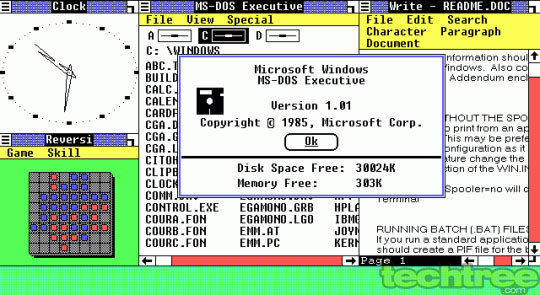 The very first version of the mighty Windows had rather humble beginnings. It was not a true OS, but rather a GUI or "shell" for DOS with limited multitasking. It encountered a lot of problems during the development phase, taking over two years to release from the time it was announced. Here's an interesting account of the struggle to make the software, recounted directly by Tandy Trower, the then Product Manager who actually "rescued" the project. View more screenshots here. In a lighter vein, watch current CEO Steve Ballmer go ballistic about the OS in this sales video:
The very first version of the mighty Windows had rather humble beginnings. It was not a true OS, but rather a GUI or "shell" for DOS with limited multitasking. It encountered a lot of problems during the development phase, taking over two years to release from the time it was announced. Here's an interesting account of the struggle to make the software, recounted directly by Tandy Trower, the then Product Manager who actually "rescued" the project. View more screenshots here. In a lighter vein, watch current CEO Steve Ballmer go ballistic about the OS in this sales video:
Windows 2.0
Released: 9-Dec-1987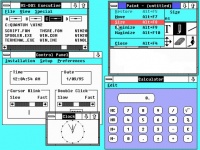 This next version sported an improved UI, better memory management, and keyboard shortcuts. View more screenshots here. It was the first version that allowed windows to overlap instead of arranging them in adjacent tiles, and the last version that could be run directly from a floppy disk. Subsequent iterations required the computer to have a hard disk in order to install the software. While it was not a commercial success, it nevertheless laid the groundwork for Windows 3.0, with which Microsoft tasted its first big success in the GUI market.
This next version sported an improved UI, better memory management, and keyboard shortcuts. View more screenshots here. It was the first version that allowed windows to overlap instead of arranging them in adjacent tiles, and the last version that could be run directly from a floppy disk. Subsequent iterations required the computer to have a hard disk in order to install the software. While it was not a commercial success, it nevertheless laid the groundwork for Windows 3.0, with which Microsoft tasted its first big success in the GUI market.
Windows 2.1
Released: 27-May-1988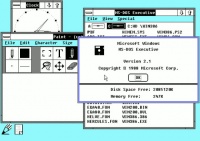 Win 2.1 was the first version of the GUI to take advantage of the Intel 80386 CPU's Virtual 8086 Mode. The Windows/386 variant of the software used this feature to simultaneously run multiple DOS programmes. To extol the benefits of this enhanced version, Microsoft released an unintentionally hilarious promotional video, probably made by people high on powerful hallucinogens. Skip to 7:00 in the video if you're too impatient to sit through the entire 12-minute clip.
Win 2.1 was the first version of the GUI to take advantage of the Intel 80386 CPU's Virtual 8086 Mode. The Windows/386 variant of the software used this feature to simultaneously run multiple DOS programmes. To extol the benefits of this enhanced version, Microsoft released an unintentionally hilarious promotional video, probably made by people high on powerful hallucinogens. Skip to 7:00 in the video if you're too impatient to sit through the entire 12-minute clip.
Windows 3.0
Released: 22-May-1990
This new version of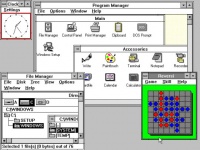 Windows was MS's first big commercial hit in the series, and there was no looking back for the company after that. It marked many firsts with its release, a few of which are mentioned here. It was the first version to have the grey-text-on-blue-background theme for the setup programme, a tradition that's continued to the present day. It introduced the concept of the Program Manager with its icons and groups, carried forward in every version since then. Not to mention the card game Solitaire, now a Windows staple, made its debut. Finally, it was the first to be shipped pre-installed with PCs, due to a deal made by MS with Zenith Data Systems (not to be confused with the Indian Zenith Computers).
Windows was MS's first big commercial hit in the series, and there was no looking back for the company after that. It marked many firsts with its release, a few of which are mentioned here. It was the first version to have the grey-text-on-blue-background theme for the setup programme, a tradition that's continued to the present day. It introduced the concept of the Program Manager with its icons and groups, carried forward in every version since then. Not to mention the card game Solitaire, now a Windows staple, made its debut. Finally, it was the first to be shipped pre-installed with PCs, due to a deal made by MS with Zenith Data Systems (not to be confused with the Indian Zenith Computers).
Ironically, Win 3.0 as we know it almost never got made, since MS was considering using IBM's OS/2 instead as a base for its next GUI. This was due to the limitations of Win 2.x that restricted the amount of usable system RAM to 1 MB. However, a couple of intrepid software engineers in the company, David Weise and Murray Sargent, demonstrated that the older version could be ported to work with the 386 CPU in Protected Mode, thus allowing it to use all of the available RAM. At the same time, Bill Gates was by then fed up of IBM's high-handedness and slow pace of development of the OS/2 variant. Therefore, the go-ahead was given to focus on further developing the indigenous Windows line instead of relying on IBM. The rest, as they say, is history. Click here for more screenshots.
Windows 3.1
Released: 6-Apr-1992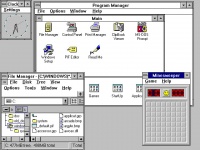 While very similar to its predecessor, Win 3.1 was the first version to be distributed on a CD-ROM. The introduction of 32-bit disk access meant it ran a lot faster. It was also the first iteration to feature drag-and-drop for icons, inbuilt support for multimedia (CD-ROMs and sound cards), TrueType fonts, and the Registry service for storing system settings (which would become a critical feature in Windows 95). On the entertainment front, Minesweeper made its debut, replacing the traditional Reversi in the process. A later 32-bit add-on called Win32s also introduced the card game Freecell. View more screenshots here.
While very similar to its predecessor, Win 3.1 was the first version to be distributed on a CD-ROM. The introduction of 32-bit disk access meant it ran a lot faster. It was also the first iteration to feature drag-and-drop for icons, inbuilt support for multimedia (CD-ROMs and sound cards), TrueType fonts, and the Registry service for storing system settings (which would become a critical feature in Windows 95). On the entertainment front, Minesweeper made its debut, replacing the traditional Reversi in the process. A later 32-bit add-on called Win32s also introduced the card game Freecell. View more screenshots here.
The reason Win 3.1 finds mention here is because its release marked an outstanding year for MS. Due to a combination of marketing and bundling with PCs, it gained widespread use. Also, MS released Office for Windows 3.1 at around the same time, which made for a great productivity tool in corporate environments and upstaged Apple's Macintosh. As a result, Win 3.1 sold over 2 million copies in the first few months itself, and for the first time in history, the Windows series became the most widely-used GUI in the world. Later on, Windows 3.11, which was essentially a service pack, patched a few bugs and introduced a couple of minor new features.
Windows 95 (Version 4.0)
Released: 24-Aug-1995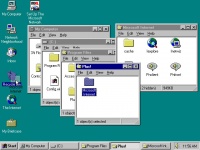 Win 95 was MS's first "true" consumer OS (even though it technically still loaded on top of DOS). It featured a radical new design (by Windows's standards) with the Start button, along with hybrid 16 and 32-bit support, as well as simplified hardware installation through its new Plug-n-Play standard. Windows Explorer took over as the primary element from the previous Program Manager, making a lot more user-friendly. Other notable features were the introduction of shortcuts for opening files (earlier restricted only to programmes), long filename support (greater than 8 characters, spaces allowed), inbuilt networking capability, and the new DirectX for much faster multimedia and gaming performance. More screens are available here.
Win 95 was MS's first "true" consumer OS (even though it technically still loaded on top of DOS). It featured a radical new design (by Windows's standards) with the Start button, along with hybrid 16 and 32-bit support, as well as simplified hardware installation through its new Plug-n-Play standard. Windows Explorer took over as the primary element from the previous Program Manager, making a lot more user-friendly. Other notable features were the introduction of shortcuts for opening files (earlier restricted only to programmes), long filename support (greater than 8 characters, spaces allowed), inbuilt networking capability, and the new DirectX for much faster multimedia and gaming performance. More screens are available here.
Thanks to a promotional $300 million blitzkrieg that involved giving away 1.5 million copies of The Times newspaper in the UK, this was the first MS product that people actually queued up to buy on the day of its launch. Co-inciding with the rise of the internet, Win 95 made Microsoft a truly household name. Its new startup screen and Plus! add-on pack ushered in the craze for customizing the PC with various themes and wallpapers. The Plus! pack also bundled the first version of MS's browser, Internet Explorer 1.0. Here's an old commercial for the OS, but beware — it might give you epileptic seizures!
Windows 98 (Version 4.1)
Released: 25-Jun-1998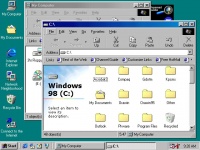 The new OS brought many much-needed improvements to components such as Plug-n-Play, USB, power management, networking, and driver support. It also introduced new technologies such as FAT32, thus removing the 2 GB HDD partition limit of the 16-bit FAT (and imposing a new one of 32 GB). Numerous other changes and feature additions including those through the Windows 98 Second Edition update, ensured that this OS was the most stable yet, and can therefore be called the pinnacle of achievement in the DOS-based line of GUIs. This fact is even more evident when compared to the mess its successor Windows Me was. On the negative side, MS's attempt to force Internet Explorer on users by tightly integrating it with Windows Explorer caused some usability issues, as well as anti-monopoly lawsuits from competing browsers a few years later. Not to mention, Active Desktop (place a webpage as your wallpaper — why?!) was a complete flop, and rightly so.
The new OS brought many much-needed improvements to components such as Plug-n-Play, USB, power management, networking, and driver support. It also introduced new technologies such as FAT32, thus removing the 2 GB HDD partition limit of the 16-bit FAT (and imposing a new one of 32 GB). Numerous other changes and feature additions including those through the Windows 98 Second Edition update, ensured that this OS was the most stable yet, and can therefore be called the pinnacle of achievement in the DOS-based line of GUIs. This fact is even more evident when compared to the mess its successor Windows Me was. On the negative side, MS's attempt to force Internet Explorer on users by tightly integrating it with Windows Explorer caused some usability issues, as well as anti-monopoly lawsuits from competing browsers a few years later. Not to mention, Active Desktop (place a webpage as your wallpaper — why?!) was a complete flop, and rightly so.
Nevertheless, Win 98 SE proved to be so popular that MS had to extend its support (in the form of updates and customer help) for an additional 2.5 years over the original date. Finally, on 11th July 2006, the OS was declared "obsolete". Even so, the OS continued to be used by low-end systems for several more years, making it the longest-lasting iteration after Windows XP.
Windows Me (Version 4.9)
Released: 14-Sep-2000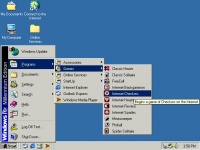 Windows Millennium Edition was launched in late 2000 as the last OS to be based on the 9x kernel. While still retaining the old core and adding a few updates, it attempted to bring in the look and feel of Windows 2000. Essentially, it was a transitional step to MS's new consumer OS based on the NT (New Technology) kernel. However, it ended up combining the worst of both worlds by messing up certain critical NT features that made the system inherently unstable, as well as removing support for DOS mode and angering long-time users. It introduced new features such as System Restore and Automatic Updates, but bugs in the former caused users more grief. To its credit though, Win Me had much improved USB, multimedia, networking support, and gaming performance than 98 SE. All said and done, it's widely considered to be among the worst OSes ever made by MS, and was quickly relegated to the dustbin.
Windows Millennium Edition was launched in late 2000 as the last OS to be based on the 9x kernel. While still retaining the old core and adding a few updates, it attempted to bring in the look and feel of Windows 2000. Essentially, it was a transitional step to MS's new consumer OS based on the NT (New Technology) kernel. However, it ended up combining the worst of both worlds by messing up certain critical NT features that made the system inherently unstable, as well as removing support for DOS mode and angering long-time users. It introduced new features such as System Restore and Automatic Updates, but bugs in the former caused users more grief. To its credit though, Win Me had much improved USB, multimedia, networking support, and gaming performance than 98 SE. All said and done, it's widely considered to be among the worst OSes ever made by MS, and was quickly relegated to the dustbin.
Windows XP (Version 5.1)
Released: 25-Oct-2001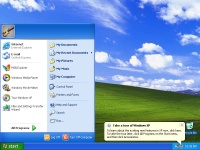 Probably the best Microsoft OS of all time (and certainly the most popular), Windows eXPerience was built from the ground up to be the first consumer OS using the NT kernel. It's a true 32-bit system (with a 64-bit version released later for modern CPUs) that finally does away with the DOS mode. The result is unparalleled stability and performance as compared to 9x systems. While MS claimed that the UI had been extensively redesigned, it's still a derivative of the old Win 95 interface, just better looking. Also, due to the extreme popularity of Windows — and the subsequent massive levels of piracy — XP was the first OS to feature an "activation" mechanism, whereby users had to connect to the MS server or feed in an authentication code based on a product key, in order to continue using the OS. Unfortunately, it was very easily defeated by crackers.
Probably the best Microsoft OS of all time (and certainly the most popular), Windows eXPerience was built from the ground up to be the first consumer OS using the NT kernel. It's a true 32-bit system (with a 64-bit version released later for modern CPUs) that finally does away with the DOS mode. The result is unparalleled stability and performance as compared to 9x systems. While MS claimed that the UI had been extensively redesigned, it's still a derivative of the old Win 95 interface, just better looking. Also, due to the extreme popularity of Windows — and the subsequent massive levels of piracy — XP was the first OS to feature an "activation" mechanism, whereby users had to connect to the MS server or feed in an authentication code based on a product key, in order to continue using the OS. Unfortunately, it was very easily defeated by crackers.
As a result of the switch to the new NT kernel, the features and improvements are too numerous to mention. Suffice it to say that XP was superior to 9x in every way, with minimal compatibility issues. DOS fanboys felt left out for a while, but were quickly appeased by the emergence of emulators such as DOSBox that could play practically every DOS game made, complete with sound effects and mouse control. Due to these reasons, the OS is extensively used even today with a current market share of 25%, forcing MS to extend support for it until April 2014. The fact that XP is in wide circulation more than a decade after its launch is testament to its legendary status. Watch Ballmer reprise his role as a crazy salesman in this video:
Windows Vista (Version 6.0)
Released: 30-Jan-2007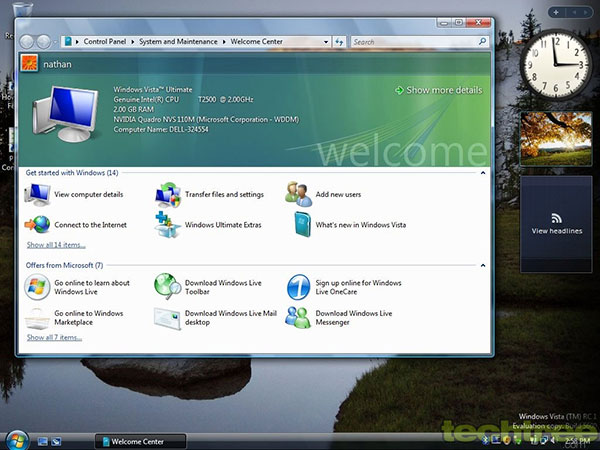 When Vista came along at the beginning of 2007, people might have been forgiven for thinking that MS was on some kind of schizophrenic trip as far as its consumer OSes were concerned. After the peak of 98 SE, out came a dud like Win Me. Similarly, in stark contrast to the exceptional XP, Vista could be best described as a half-baked attempt — surprising, considering the amount of time MS had to perfect it. The interface was essentially the same as before, just with tonnes of eye-candy thrown in, including translucent windows and title bars. So much so, in fact, that users complained bitterly about the fancy Aero interface causing the system to become sluggish and raise system requirements to an insane level (for an OS).
When Vista came along at the beginning of 2007, people might have been forgiven for thinking that MS was on some kind of schizophrenic trip as far as its consumer OSes were concerned. After the peak of 98 SE, out came a dud like Win Me. Similarly, in stark contrast to the exceptional XP, Vista could be best described as a half-baked attempt — surprising, considering the amount of time MS had to perfect it. The interface was essentially the same as before, just with tonnes of eye-candy thrown in, including translucent windows and title bars. So much so, in fact, that users complained bitterly about the fancy Aero interface causing the system to become sluggish and raise system requirements to an insane level (for an OS).
The Start Menu was redesigned (badly), common tasks became less intuitive rather than more, and an irritating sidebar with "gadgets" you were supposed to configure was forcibly thrown in, going completely against the idea of having a "clean" desktop. As for security? Let's not even begin discussing that annoying feature called User Account Control that kept popping up with infuriating regularity. Did I mention the numerous and confusing variants of the OS that you had to pick from? In short, Vista was plagued with poor performance, compatibility issues with older software, a lack of proper drivers (in the initial stages), and security overkill. Probably the only demographic happy with the new OS was hardcore gamers, who saw a significant improvement in graphics quality with the new DirectX10.
If you think this is just a personal rant, the numbers speak for themselves. At its peak, just before its successor Windows 7 was due, Vista had a market share of just 19%, as opposed to 63% for XP. Currently, this figure stands at 8% and 25% respectively. Of course, MS claimed that a lot more copies of Vista had been sold as compared to XP in the same period, but conveniently forgot to explain the reason for this statistic: the world had added millions more PCs and laptops in the years between the OSes. Incidentally, at around this time, MS's monopolistic sins came back to bite it in the ass, resulting in a record $1.3 billion fine.
Windows 7 (Version 6.1)
Released: 22-Jul-2009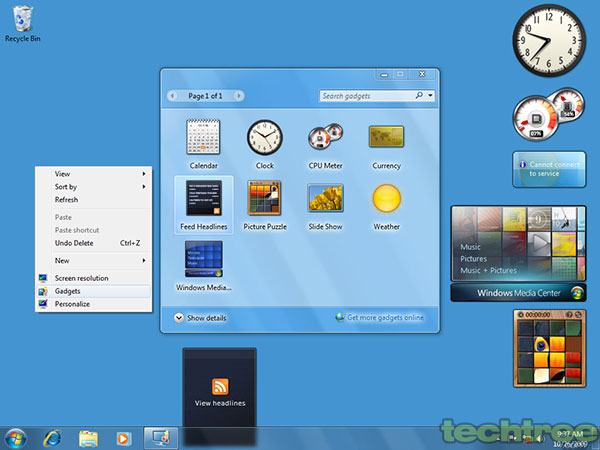 Fortunately, the next attempt saw Microsoft make amends to its previous blunder. While only being an incremental upgrade (as evinced by the 0.1 increase in version number), it took the earlier OS and discarded the excess baggage of fancy graphics and overzealous security. The result was a Windows that looked and performed much better than its predecessor, with support for the latest hardware and new technologies to boot. The Taskbar was upgraded to a Superbar, with "pinnable" programme icons replacing the classic title bar of previous versions. This was not necessarily a good thing though, especially if you were a long-time user who'd worked with the classic taskbar for nearly 15 years. More bad news came in the form of the classic Start Menu having been completely done away with, the XP-style expanding menu system showing no signs of a comeback, and the ghastly Ribbon toolbar from MS Office infecting the standard Paint and WordPad applications as well.
Fortunately, the next attempt saw Microsoft make amends to its previous blunder. While only being an incremental upgrade (as evinced by the 0.1 increase in version number), it took the earlier OS and discarded the excess baggage of fancy graphics and overzealous security. The result was a Windows that looked and performed much better than its predecessor, with support for the latest hardware and new technologies to boot. The Taskbar was upgraded to a Superbar, with "pinnable" programme icons replacing the classic title bar of previous versions. This was not necessarily a good thing though, especially if you were a long-time user who'd worked with the classic taskbar for nearly 15 years. More bad news came in the form of the classic Start Menu having been completely done away with, the XP-style expanding menu system showing no signs of a comeback, and the ghastly Ribbon toolbar from MS Office infecting the standard Paint and WordPad applications as well.
The Search menu entry had completely disappeared from the Start Menu, so you either had to use the search box in the menu, or the one in the top right corner of Windows Explorer. Since this prevented you from easily accessing the advanced search options, it seemed to be a rather dumb move. Sharing files across a network was still more of a hassle than it should be, and a royal pain if one of the systems happens to be XP. Finally, the OS isn't as stable as MS would like to believe, as I've personally seen mysterious Windows Explorer crashes frequently recurring on a couple of PCs.
Overall, Windows 7 was a mixed bag of features, with many positives and a few negatives. While it was enthusiastically accepted by one and all, that's probably because going back to XP was not an option, and just about anything's better than Vista. As an interesting aside, due to the anti-trust ruling imposed against it, MS was forced to let European users choose which browser they wanted at the time of installing Windows 7. Serve it right, I say.
Windows 8 (Version 6.2)
Release Date: Late 2012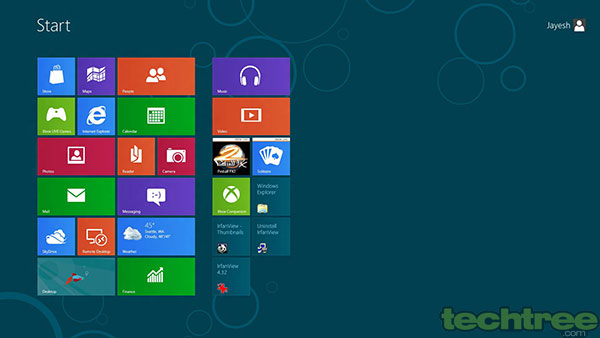 Expected later this year, Win 8 is the first OS since Win 95 to completely overhaul the familiar user interface. With touchscreens becoming the norm, it merges both the tablet and PC versions into one, with the mobile variant Windows Phone 8 and future Xbox 360 interface probably having the same look and feel as well. Thus, MS is moving towards a common platform for all computing devices, which makes sense. While you wait with bated breath for MS's latest system, refer to our guide on running this OS off a USB drive, and check our Windows page for the latest news on this exciting new OS. You can also find more interface screens here. There's no denying that Windows will be around for a lot more time to come, and will continue to evolve throughout — sometimes for the worse, but hopefully, mostly for the better.
Expected later this year, Win 8 is the first OS since Win 95 to completely overhaul the familiar user interface. With touchscreens becoming the norm, it merges both the tablet and PC versions into one, with the mobile variant Windows Phone 8 and future Xbox 360 interface probably having the same look and feel as well. Thus, MS is moving towards a common platform for all computing devices, which makes sense. While you wait with bated breath for MS's latest system, refer to our guide on running this OS off a USB drive, and check our Windows page for the latest news on this exciting new OS. You can also find more interface screens here. There's no denying that Windows will be around for a lot more time to come, and will continue to evolve throughout — sometimes for the worse, but hopefully, mostly for the better.
Software, Internet, Windows, Microsoft, Internet Explorer, Jayesh
Three Decades Of Windows: A Retrospective | TechTree.com
Three Decades Of Windows: A Retrospective
We take a look how the world's most popular OS has evolved over the years.
News Corner
- DRIFE Begins Operations in Namma Bengaluru
- Sevenaire launches ‘NEPTUNE’ – 24W Portable Speaker with RGB LED Lights
- Inbase launches ‘Urban Q1 Pro’ TWS Earbuds with Smart Touch control in India
- Airtel announces Rs 6000 cashback on purchase of smartphones from leading brands
- 78% of Indians are saving to spend during the festive season and 72% will splurge on gadgets & electronics
- 5 Tips For Buying A TV This Festive Season
- Facebook launches its largest creator education program in India
- 5 educational tech toys for young and aspiring engineers
- Mid-range smartphones emerge as customer favourites this festive season, reveals Amazon survey
- COLORFUL Launches Onebot M24A1 AIO PC for Professionals







Reader Comments (12)